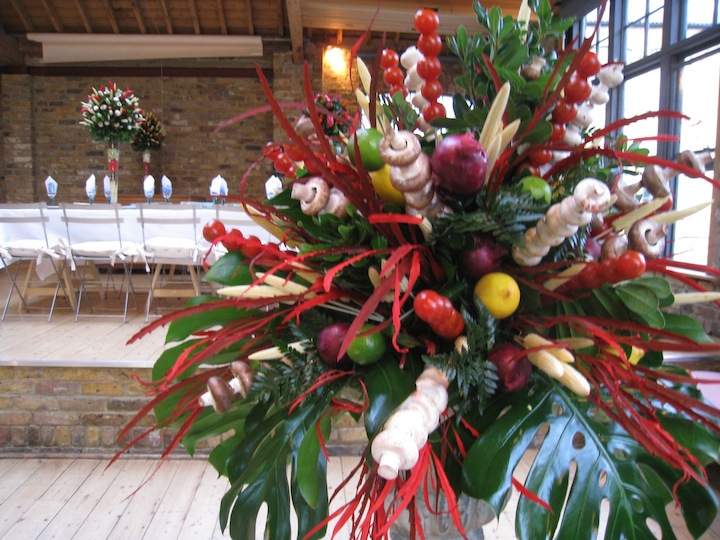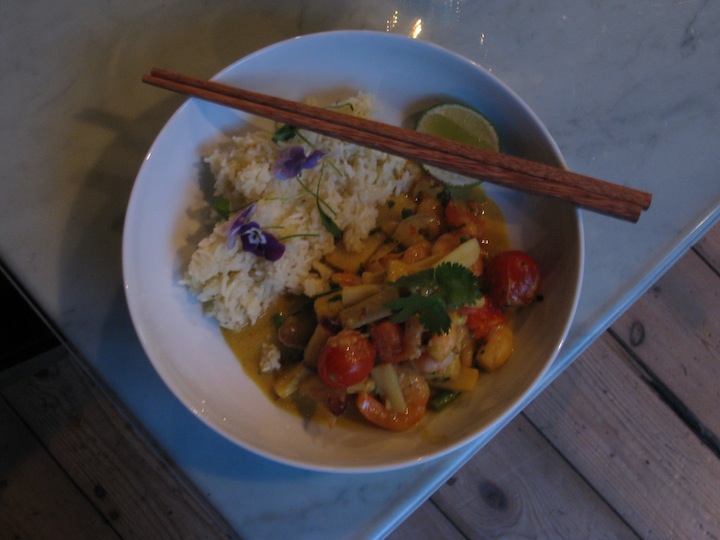I couldn’t quite believe what I had just read. It wasn’t until 1955 that “hummus” first appeared in English? I was willing to believe the BBC piece on the state-of-hummus in the UK in terms of its modern trendiness, massively growing sales, first appearance in Waitrose in the late ’80s, M&S in 1990. Britain eats 12,000 tons of hummus each year these days, apparently.
1955 just seems so recent for a word import when guidebooks or anthropological studies might have been using it sooner than Elizabeth David in Mediterranean Food. But there it was in the OED, just as the article’s author claimed.
I went looking, but every hit on Google’s ngram viewer for before 1955 for “houmous” seems to be an OCR error for “burnous”. Eleanor Cecilia Donnelly’s 1896 book A Tuscan Magdalen didn’t mean what we would when she was mis-OCR’d as writing, “‘Prostrate thyself in this lone desert place, And in thy houmous muffle up thy face?'”
“mashed chick peas” got me further, but nothing quickly which wasn’t from Latin America or was a pottage. Broadening the scope, there are “chich” pea recipes from the fourteenth century; they’re used in The Forme of Cury. Around the same time, the Wycliffe Bible offers this translation of 2 Sam. xvii. 28 “Fried chichis [Vulg. frixum cicer], and hony.”
But coming back to the main point – the OED sometimes misses out on still-earlier references to something. But in this case, it looks like they’re right after all. “Hummus” was first published in English in 1955 by Elizbaeth David.
A combination of a thoughtful friend and corporate marketing generosity led me to eat dinner last week in a lovely space more usually used for photography shoots. A dozen of us arrived for an event which far surpassed its somewhat unpromising invitation. (A “new range of meal solutions” are not words which should be allowed out into the wild, for starters.)
We were greeted with cocktails made by a flair-wielding bartender, and by representatives of the marketing agency and the brand, Lyons Seafoods, whose products were the evening’s centerpiece. Gorgeous, towering displays in vases of vegetables represented each of the four dishes being launched. The vegetable display was a genius idea on someone’s part. Our conversations looped regularly back around to how impressive and well-done they were.

This was not a meal which began with eating – although there were nibbles to go with our cocktails – but with cooking. We each chose a dish and a chef equipped with a plethora of woks cooked them up, one variety at a time. It doubled as a group deduction as to why professional chefs so often do not use stirring spoons when a home chef would: spoons would carry contaminants from raw to cooked phases of a dish.Also, cooking lots of dishes at once can easily result in spoon-confusion. (I came home and have been practicing tossing my food about in pots ever since. Only one minor disaster so far.)
Along with two others, I opted for the modestly-spicy Malaysian prawn laksa. After being cooked, a food stylist took over for plating and decorating. Our tidy piles of rice and laksa were scattered with micro-coriander and pretty purple violas. A slice of lime completed the presentation.

Since we were sent home with all four of the feeds-two-each quick-cooking variants to try, I can tell you about their commonalities. The meals are designed as easy-to-cook, refridgerated compartments of pre-cut vegetables, fish and/or prawns, and a sauce sachet. None of them are meant to take more than 6 minutes to cook, and none of them did. Admirable attention has been put into texture and color contrast, with all of them featuring a good variety of both. They’re all well-rounded, with enough meat and vegetables built-in for a comfortable portion size. (Not ample; comfortable.)
Of course a lot of thought was put into the design of these meals, but that was brought home in hearing of some of the other tasty dishes developed in early stages of the line which didn’t look to have enough of a market in the UK to make them worth launching. American classics of chowder and jambalaya, for example, did not make the final cut; at least, not for the launch.
My favorite of the four was the Catalan fish stew, whose taste dimensions were rounded out by thin slices of cured chorizo. It’s also the only one with neither gluten nor dairy products among the ingredients.
The Kerala curry had a touch of dairy in the sauce, but no gluten. The Thai sweet chili king prawns had personality, though no real heat; still, it was no rollover dish. It had presence, and I didn’t mind at all eating it for two meals in a row, as ended up happening.
The consensus among the various people I ate these meals with was that they’re solid choices, good food worth eating when an easy-to-cook meal is the right choice. One friend observed her price point for these was right where the introductory offer put them, at £4.99 each.
For now, the Lyons Seafoods dinners are only available in the UK’s 150 largest Sainsburys.
P.S. I have no good etymological source for “laksa”, but it may either come from a kind of noodle whose name, in turn, derives from the Sanskrit “lakshas”, or a hundred thousand; or it dervies from the Cantonese “spicy sand”, for grit of the ground dried prawns in the sauce. I quite like the idea of a stew named after a large number.
Earlier this year, I annotated a series of historical recipes for Viewpoint, the newsletter of the British Society for the History of Science. Someone wrote in to observe I had misspelled “zweiback” in the recipe copied verbatim from a 1960s US Little League cookbook.
Here was my reply:
I understand well the frustration of seeing a familiar word mis-adapted into other languages; I have still not wholly reconciled myself to “biscotti” being a singular noun in English.
As for “Zwieback”, it does indeed etymologically mean “twice baked”. Both “zwieback” and “zweiback” are spelling variations attested in seventeenth-century German. (Grimm and Grimm, Deutsches Wörterbuch) In English, therefore, the word “zweiback” is that interesting category of mispelling, the hypercorrection. Indeed, the spelling “zweiback” is the first attested instance of the word in English, in 1894 in the N.Y. Weekly Tribune. (OED)
While I grant that I know no contemporary dictionary which had approved the e-before-i spelling, it is nevertheless a widely-used variation in the United States, to such a degree that I had largely stopped seeing it. Not only is the “zweiback”well-used in recipe books – such as the Memphis Cookbook whose spelling as well as recipe I borrowed – but in commercial production by Log House Foods, which sells “Log House Original Zweiback Toast”.
I said, “I come from hog country”, and she was jealous, wishing she could say she was from somewhere like that. I asked her where she was from, and she hesitated scarcely a second before replying, “Butter pie country”.
I’d never heard of butter pies, so I asked her where they were from. The Preston-Blackpool-Wigan area, she said (I simplify). I’ve spent a lot of time around there, but never run across them. Why? They aren’t something baked at home, but bought out of the fridge from the local corner shop. They’re a snack, a local specialty, a place to come from.
After establishing that they had very little in common with that Canadian sweet, butter tart, I saved further knowledge for today. So: they’re the Cornish pasty of Lancashire. They’re purportedly of Catholic origin, made from onions and mashed or sliced potatoes and no meat, and so know alternately as “Catholic” or “Friday pies”. That also makes them a vegetarian option for menus aiming with local Lancashire themes.
They used to be a staple of Preston North End football games, until the baked goods company supplying the stadium had the biscuit. But they’re still made by various very local companies and one can, of course, make it at home. How much are they eaten fresh, how much bought as they “should” be, according to the woman from butter pie country, straight out of the corner store fridge? I don’t know.
The pie’s fame was ensconced – relatively speaking – by a Paul McCartney song, “Uncle Albert/Admiral Halsey”: “I had another look and I had a cup of tea and butter pie. (Butter pie?) The butter wouldn’t melt so I put it in the pie”. There’s really no more butter in the pie than any pie one might make with butter as the choice of pastry fat.
Hotpot is the better-known Lancashire dish. A Lancashire Evening Post article last year stirred up some local outrage over “real hotpot” made with lamb from New Zealand. I was charmed to see that one of the commenters replying to the article wrote, “The only true Lancashire dish is The Butter Pie. Oh, and Parched Peas”
Zynga is a powerhouse among gaming companies. As of last year, their Farmville was one of the world’s most played games. Their newest, CityVille, garnered a hundred million users within six weeks. That’s approximately the entirely population of Mexico, or a third of the population of the U.S.
I haven’t played either of those games, but a friend lured me into trying out one of Zynga’s other games, Frontierville, with the promise that it offered interesting food-related things. And indeed it did.
About a week and a half ago, a new in-game quest gave users the chance to make something called “rubaboo stew” as a way of welcoming a new character to the game, a French frontier trader named Jacques, complete with bad accent. The stew’s name looked ridiculous, but nothing else the game had previously offered was wholly made up, so I went to have a look for more information.
The stew is exactly what the game says it is: a stew made by fur traders and possible native peoples out of peas and bacon or, more generally, made from peas or corn and animal fat, whether bear or pig. It was often sweetened with a bit of maple syrup.
Until two weeks ago, I’d wager that rubaboo was a fairly obscure word, most likely to be encountered by those immersed in Canadiana. There was a Canadian journal for kids by that name in the 1960s. A 1976 book, Colombo’s Canadian References, says that rubaboo was an Algonquin word for the stew, soup, or broth eaten by fur traders. (The OED agrees.) 1821 was the earliest-recorded English language reference to it.
All sorts of children’s books set in frontier Canada make use of it. Here an excerpt from Willa’s New World: “‘The rubaboo? Onions, turnips, venison…whatever I have. Sometimes dried meat, though not as good as the pemmican we make back home.'” A magazine from 1907, Canadian, describes it as synonymous with pemmican stew. Water, flour, and fat is another frequently-used descriptor of what it contained. Skunks, patridges, and smaller birds could all be incorporated into it.
As of two days after the quest’s release in the game, Google hits only amounted to about 300 for “rubaboo stew”. They’re up to a thousand now. The distinctive imprint which Zynga has put onto references to it is the addition of “stew”, a word which is redundant to the original, but explains what this dish is, very briefly, for the sake of their players. Stew is again a generic word, forgiving of innumerable adjectives, which explains an unfamiliar dish without making it necessary for the casual reader to find out just what rubaboo is or was. “rubaboo” has ten times the number of references as the phrase “rubaboo stew”, but most are to the 1960s children’s magazine, rather than the foodstuff per se.
 © S. Worthen 2009
© S. Worthen 2009